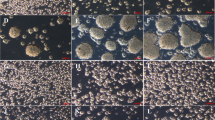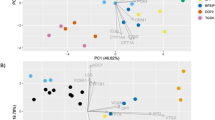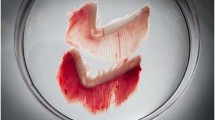Abstract
Fish cell spheroids are promising 3D culture models for vertebrate replacement in ecotoxicology. However, new alternative ecotoxicological methods must be adapted for applications in industry and for regulatory purposes; such methods must be cost-effective, simple to manipulate and provide rapid results. Therefore, we compared the effectiveness of the traditional hanging drop (HD), orbital shaking (OS), and HD combined with OS (HD+OS) methods on the formation of zebrafish cell line spheroids (ZFL and ZEM2S). Time in HD (3–5 days) and different 96-well plates [flat-bottom or ultra-low attachment of round-bottom (ULA-plates)] in OS were evaluated. Easy handling, rapid spheroid formation, uniform-sized spheroids, and circularity were assessed to identify the best spheroid protocol. Traditional HD alone did not result in ZFL spheroid formation, whereas HD (5 days)+OS did. When using the OS, spheroids only formed on the ULA-plate. Both HD+OS and OS were reproducible in size (177.50 ± 2.81 µm and 225.62 ± 19.20 µm, respectively) and circularity (0.83 ± 0.02 and 0.80 ± 0.01, respectively) of ZFL spheroids. Nevertheless, HD+OS required a considerable time to completely form spheroids (10 days) and intensive handling, whereas the OS was fast (5 days of incubation) and simple. OS also yielded reproducible ZEM2S spheroids in 1 day (226.23 ± 0.57 µm diameter and 0.80 ± 0.01 circularity). In conclusion, OS in ULA-plate is an effective and simple spheroid protocol for high-throughput ecotoxicity testing. This study contributes to identify a fast, reproducible, and simple protocol of single piscine spheroid formation in 96-well plates and supports the application of fish 3D model in industry and academia.









Similar content being viewed by others
Data availability
The datasets generated during and/or analyzed during the current study are available from the corresponding author on reasonable request.
References
Alessandri K, Sarangi BR, Gurchenkov VV, Sinha B, Kießling TR, Fetler L, Rico F, Scheuring S, Lamaze C, Simon A, Geraldo S, Vignjević D, Doméjean H, Rolland L, Funfak A, Bibette J, Bremond N, Nassoy P (2013). Cellular capsules as a tool for multicellular spheroid production and for investigating the mechanics of tumor progression in vitro. PNAS. https://doi.org/10.1073/pnas.1309482110
Bairoch A (2018) The cellosaurus, a cell-line knowledge resource. J Biomol Tech 29:25–38. https://doi.org/10.7171/jbt.18-2902-002.
Baron MG, Mintram KS, Owen SF, Hetheridge MJ, Moody AJ, Purcell WM, Jackson SK, Jha AN (2017). Pharmaceutical metabolism in fish: Using a 3-D Hepatic in Vitro model to assess clearance. PLoS ONE. https://doi.org/10.1371/journal.pone.0168837
Baron MG, Purcell WM, Jackson SK, Owen SF, Jha AN (2012). Towards a more representative in vitro method for fish ecotoxicology: Morphological and biochemical characterisation of three-dimensional spheroidal hepatocytes. Ecotoxicology. https://doi.org/10.1007/s10646-012-0965-5
Bell CC, Hendriks DFG, Moro SML, Ellis E, Walsh J, Renblom A, Puigvert LF, Dankers ACA, Jacobs F, Snoeys J, Sison-Young RL, Jenkins RE, Nordling Å, Mkrtchian S, Park BK, Kitteringham NR, Goldring CEP, Lauschke VM, Ingelman-Sundberg M (2016). Characterization of primary human hepatocyte spheroids as a model system for drug-induced liver injury, liver function and disease. Sci. Rep. https://doi.org/10.1038/srep25187
Biswas S, Emond MR, Jontes JD (2010). Protocadherin-19 and N-cadherin interact to control cell movements during anterior neurulation. J Cell Biol. https://doi.org/10.1083/jcb.201007008
Bols NC, Dayeh VR, Lee LEJ, Schirmer K (2005). Use of fish cell lines in the toxicology and ecotoxicology of fish. Piscine cell lines in environmental toxicology. Biochem Mol Biol Fishes. https://doi.org/10.1016/S1873-0140(05)80005-0
Bradford CS, Sun L, Collodi P, Barnes DW (1994) Cell cultures from zebrafish embryos and adult tissues. Meth Cell Sci 16:99–107
Burden N, Benstead R, Clook M., Doyle I, Edwards P, Maynard SK, Ryder K, Sheahan D, Whale G, van Egmond R, Wheeler JR, Hutchinson TH (2015). Advancing the 3Rs in regulatory ecotoxicology: A pragmatic cross-sector approach. Integr. Environ. Assess. Manag. https://doi.org/10.1002/ieam.1703
Busquet F, Strecker R, Rawlings JM, Belanger SE, Braunbeck T, Carr GJ, Cenijn P, Fochtman P, Gourmelon A, Hübler N, Kleensang A, Knöbel M, Kussatz C, Legler J, Lillicrap A, Martínez-Jerónimo F, Polleichtner C, Rzodeczko H, Salinas E, Schneider KE, Scholz S, van den Brandhof EJ, van der Ven LT, Walter-Rohde S, Weigt S, Witters H, Halder M (2014) OECD validation study to assess intra- and inter-laboratory reproducibility of the zebrafish embryo toxicity test for acute aquatic toxicity testing. Regul Toxicol Pharmacol 69:496–511. https://doi.org/10.1016/j.yrtph.2014.05.018
Caminada D, Escher C, Fent K (2006). Cytotoxicity of pharmaceuticals found in aquatic systems: Comparison of PLHC-1 and RTG-2 fish cell lines. Aquat Toxicol. https://doi.org/10.1016/j.aquatox.2006.05.010
Carvan MJ III, Solis WA, Gedamu L, & Nebert DW (2000). Activation of transcription factors in zebrafish cell cultures by environmental pollutants. Arch Biochem Biophys. https://doi.org/10.1006/abbi.2000.1727
Carvan MJ III, Sonntag DM, Cmar CB, Cook RS, Curran MA, Miller GL (2001). Oxidative stress in zebrafish cells: potential utility of transgenic zebrafish as a deployable sentinel for site hazard ranking. Sci. Total Environ. https://doi.org/10.1016/S0048-9697(01)00742-2
Chan KM, Ku LL, Chan PC-Y, Cheuk WK (2006). Metallothionein gene expression in zebrafish embryo-larvae and ZFL cell-line exposed to heavy metal ions. Mar Env Res. https://doi.org/10.1016/j.marenvres.2006.04.012
Costa EC, Gaspar VM, Coutinho P, Correia IJ (2014). Optimization of liquid overlay technique to formulate heterogenic 3D co-cultures models. Biotechnol Bioeng. https://doi.org/10.1002/bit.25210
Dayeh VR, Bols NC, Tanneberger K, Schirmer K, Lee LEJ (2013). The Use of fish-Derived cell lines for investigation of environmental contaminants: An update following OECD’s fish toxicity testing framework no. 171. Curr Protoc toxicol. https://doi.org/10.1002/0471140856.tx0105s56
Doonan F, Cotter TG (2008) Morphological assessment of apoptosis. Methods 44:200–4. https://doi.org/10.1016/j.ymeth.2007.11.006
Elje E, Hesler M, Rundén-Pran E, Mann P, Mariussen E, Wagner S, Dusinska M, Kohl Y (2019). The comet assay applied to HepG2 liver spheroids. Mutat Res Genet Toxicol Environ Mutagen. https://doi.org/10.1016/j.mrgentox.2019.03.006
Embry MR, Belanger SE, Braunbeck TA, Galay-Burgos M, Halder M, Hinton DE, Léonard MA, Lillicrap A, Norberg-King T, Whale G (2010). The fish embryo toxicity test as an animal alternative method in hazard and risk assessment and scientific research. Aquat Toxicol. https://doi.org/10.1016/j.aquatox.2009.12.008
Felzenszwalb I, Fernandes AS, Brito LB, Oliveira GAR, Silva PAS, Arcanjo ME, Marques MRC, Vicari T, Leme DM, Cestari MM, Ferraz ERA (2019). Toxicological evaluation of nail polish waste discarded in the environment. Environ. Sci. Pollut. Res. https://doi.org/10.1007/s11356-018-1880-y
Fennema E, Rivron N, Rouwkema J, van Blitterswijk C, De Boer J (2013). Spheroid culture as a tool for creating 3D complex tissues. Trends Biotechnol. https://doi.org/10.1016/j.tibtech.2012.12.003
Fent K (2001). Fish cell lines as versatile tools in ecotoxicology: Assessment of cytotoxicity, cytochrome P4501A induction potential and estrogenic activity of chemicals and environmental samples. Toxicol In Vitro. https://doi.org/10.1016/S0887-2333(01)00053-4
Ferreira T, Rasband W (2012). ImageJ user guide. Image J User Guide, 1.46r. https://doi.org/10.1038/nmeth.2019
Foty R (2011). A simple hanging drop cell culture protocol for generation of 3D spheroids. J Vis Exp. https://doi.org/10.3791/2720
Gajski G, Gerić M, Žegura B, Novak M, Nunić J, Bajrektarević D, Garaj-Vrhovac V, Filipič M (2016). Genotoxic potential of selected cytostatic drugs in human and zebrafish cells. Environ Sci Pollut Res Int. https://doi.org/10.1007/s11356-015-4592-6
Ghosh C, Liu Y, Ma C, Collodi P (1997). Cell cultures derived from early zebrafish embryos differentiate in vitro into neurons and astrocytes. Cytotechnology. https://doi.org/10.1023/a:1007915618413
Glicklis R, Merchuk JC, Cohen S (2004) Modeling mass transfer in hepatocyte spheroids via cell viability, spheroid size, and hepatocellular functions. Biotechnol Bioeng 86:672–80. https://doi.org/10.1002/bit.20086
He S, Salas-Vidal E, Rueb S, Krens SFG, Meijer AH, Snaar-Jagalska BE, Spaink HP (2006). Genetic and transcriptome characterization of model zebrafish cell lines. Zebrafish. https://doi.org/10.1089/zeb.2006.3.441
Ho RK, Kimmel CB (1993) Commitment of cell fate in the early. Zebrafish Embryo. Science 261:109–111
Ho WY, Yeap SK, Ho CL, Rahim RA, Alitheen NB (2012) Development of multicellular tumor spheroid (MCTS) culture from breast cancer cell and a high throughput screening method using the MTT assay. PLoS ONE 7:e44640. https://doi.org/10.1371/journal.pone.0044640
Hultman MT, Løken KB, Grung M, Reid MJ, Lillicrap A (2019) Performance of three‐dimensional rainbow trout (Oncorhynchus mykiss) hepatocyte spheroids for evaluating biotransformation of pyrene. Environ Toxicol Chem 38:1738–1747. https://doi.org/10.1002/etc.4476
Imani R, Hojjati Emami S, Fakhrzadeh H, Baheiraei N, Sharifi AM (2012) Optimization and comparison of two different 3D culture methods to prepare cell aggregates as a bioink for organ printing. Biocell. 36:37–45
Ivascu A, Kubbies M (2006). Rapid generation of single-tumor spheroids for high-throughput cell function and toxicity analysis. J. Biomol. Screen. https://doi.org/10.1177/108705710629276Y
Ivanov DP, Parker TL, Walker DA, Alexander C, Ashford MB, Gellert PR, Garnett MC (2014) Multiplexing spheroid volume, resazurin and acid phosphatase viability assays for high-throughput screening of tumour spheroids and stem cell neurospheres. PLoS ONE 9(8):e103817. https://doi.org/10.1371/journal.pone.0103817.
Jeong Y, Park C, Baek I, Jeong K, Baik S, Kim YJ. Differential Effects of CBZ-Induced Catalysis and Cytochrome Gene Expression in Three Dimensional Zebrafish Liver Cell Culture (2016). J Environ Anal Toxicol. https://doi.org/10.4172/2161-0525.1000404.
Kelm JM, Timmins NE, Brown CJ, Fussenegger M, Nielsen LK (2003). Method for generation of homogeneous multicellular tumor spheroids applicable to a wide variety of cell types. Biotechnol. Bioeng. https://doi.org/10.1002/bit.10655
Kim K, Kim SH, Lee GH, Park JY (2018). Fabrication of omega-shaped microwell arrays for a spheroid culture platform using pins of a commercial CPU to minimize cell loss and crosstalk. Biofabrication. https://doi.org/10.1088/1758-5090/aad7d3
Kim JB (2005). Three-dimensional tissue culture models in cancer biology. Semin. Cancer Biol. https://doi.org/10.1016/j.semcancer.2005.05.002
Klingelfus T, Disner GR, Voigt CL, Alle LF, Cestari MM, Leme DM (2019). Nanomaterials induce DNA-protein crosslink and DNA oxidation: A mechanistic study with RTG-2 fish cell line and Comet assay modifications. Chemosphere. https://doi.org/10.1016/j.chemosphere.2018.10.118
Kochanek SJ, Close DA, Johnston PA (2019) High content screening characterization of head and neck squamous cell carcinoma multicellular tumor spheroid cultures generated in 384-well ultra-low attachment plates to screen for better cancer drug leads. Assay Drug Dev Technol 17(1):17–36. https://doi.org/10.1089/adt.2018.896
Lakra WS, Swaminathan TR, Joy KP (2011) Development, characterization, conservation and storage of fish cell lines: a review. Fish Physiol Biochem 37(1):1–20. https://doi.org/10.1007/s10695-010-9411-x
Lammel T, Tsoukatou G, Jellinek J, Sturve J (2019). Development of three-dimensional (3D) spheroid cultures of the continuous rainbow trout liver cell line RTL-W1. Ecotoxicol. Environ. Saf. https://doi.org/10.1016/j.ecoenv.2018.10.009
Langan LM, Dodd NJF, Owen SF, Purcell WM, Jackson SK, Jha AN (2016). Direct measurements of oxygen gradients in spheroid culture system using electron parametric resonance oximetry. PLoS ONE. https://doi.org/10.1371/journal.pone.0149492
Langan LM, Owen SF, Trznadel M, Dodd NJF., Jackson SK, Purcell WM, Jha AN (2018). Spheroid size does not impact metabolism of the β-blocker propranolol in 3D intestinal fish model. Front. Pharmacol. https://doi.org/10.3389/fphar.2018.00947
Lee GH, Lee JS, Lee GH, Joung WY, Kim SH, Lee SH, Park JY, Kim DH (2017). Networked concave microwell arrays for constructing 3D cell spheroids. Biofabrication. https://doi.org/10.1088/1758-5090/aa9876. PMID: 29190216.
Lee WG, Ortmann D, Hancock MJ, Bae H, Khademhosseini A (2010). A hollow sphere soft lithography approach for long-term hanging drop methods. Tissue Eng. Part C Methods. https://doi.org/10.1089/ten.tec.2009.0248
Lillicrap A, Belanger S, Burden N, Pasquier D, Embry MR, Halder M, Lampi MA, Lee L, Norberg-King, T, Rattner BA, Schirmer K, Thomas P (2016). Alternative approaches to vertebrate ecotoxicity tests in the 21st century: a review of developments over the last 2 decades and current status. Environ Toxicol Chem. https://doi.org/10.1002/etc.3603
Lin RZ, Chou LF, Chien CCM, Chang HY (2006). Dynamic analysis of hepatoma spheroid formation: roles of E-cadherin and β1-integrin. Cell Tissue Res. https://doi.org/10.1007/s00441-005-0148-2
Liu J, Kuznetsova LA, Edwards GO, Xu J, Ma M, Purcell WM, Jackson SK, Coakley WT (2007). Functional three-dimensional HepG2 aggregate cultures generated from an ultrasound trap: comparison with HepG2 spheroids. J. Cell Biochem. https://doi.org/10.1002/jcb.21345
Ma M, Xu J, Purcell WM (2003). Biochemical and functional changes of rat liver spheroids during spheroid formation and maintenance in culture: I. Morphological maturation and kinetic changes of energy metabolism, albumin synthesis, and activities of some enzymes. J Cell Biochem. https://doi.org/10.1002/jcb.10730
Mandell KJ, Babbin BA, Nusrat A, Parkos CA (2005). Junctional adhesion molecule 1 regulates epithelial cell morphology through effects on β1 integrins and Rap1 activity. J. Biol Chem. https://doi.org/10.1074/jbc.M412650200
Meng Q, Yeung K, Chan KM (2021). Toxic effects of octocrylene on zebrafish larvae and liver cell line (ZFL). Aquat Toxicol. https://doi.org/10.1016/j.aquatox.2021.105843.
Mosmann T (1983) Rapid colorimetric assay for cellular growth and survival: application to proliferation and cytotoxicity assays. J Immunol Methods 65(1-2):55–63. https://doi.org/10.1016/0022-1759(83)90303-4
Mueller-Klieser W. Method for the determination of oxygen consumption rates and diffusion coefficients in multicellular spheroids (1984). Biophys J. https://doi.org/10.1016/S0006-3495(84)84030-8.
Nagelkerke A, Bussink J, Sweep FCGJ, Span PN (2013). Generation of multicellular tumor spheroids of breast cancer cells: How to go three-dimensional. Anal Biochem. https://doi.org/10.1016/j.ab.2013.02.004
Norberg-King TJ, Embry MR, Belanger SE, Braunbeck T, Butler JD, Dorn PB, Farr B, Guiney PD, Hughes SA, Jeffries M, Journel R, Lèonard M, McMaster M, Oris JT, Ryder K, Segner H, Senac T, Van Der Kraak G, Whale G, Wilson P (2018). An international perspective on the tools and concepts for effluent toxicity assessments in the context of animal alternatives: reduction in vertebrate use. Environ. Toxicol. Chem. https://doi.org/10.1002/etc.4259
Norrgren L (2012). Fish models for ecotoxicology. Acta Vet. Scand. https://doi.org/10.1186/1751-0147-54-S1-S14
Ohnuki Y, Kurosawa H (2013). Effects of hanging drop culture conditions on embryoid body formation and neuronal cell differentiation using mouse embryonic stem cells: Optimization of culture conditions for the formation of well-controlled embryoid bodies. J. Biosci. Bioeng. https://doi.org/10.1016/j.jbiosc.2012.11.016
Oliveira GAR, Leme DM, Lapuente J, Brito LB, Porredón C, Rodrigues LB, Brull N, Serret JT, Borràs M., Disner GR, Cestari MM, Oliveira DP (2018). A test battery for assessing the ecotoxic effects of textile dyes. Chem. Biol. Interact. https://doi.org/10.1016/j.cbi.2018.06.026
Pagé B, Page M, Noel C (1993) A new fluorometric assay for cytotoxicity measurements in-vitro. Int J Oncol 3(3):473–6
Puck TT, Cieciura SJ, Fisher HW (1957) Clonal growth in vitro of human cells with fibroblastic morphology. J. Exp. Med. 106(1):145–158
Ruyra A, Torrealba D, Morera D, Tort L, MacKenzie S, Roher N (2015). Zebrafish liver (ZFL) cells are able to mount an anti-viral response after stimulation with Poly (I:C). Comp. Biochem. Physiol. https://doi.org/10.1016/j.cbpb.2014.12.002
Sanchez W, Porcher JM (2009). Fish biomarkers for environmental monitoring within the water framework directive of the European union. Trends Analyt Chem. https://doi.org/10.1016/j.trac.2008.10.012
Sant S, Johnston PA. The production of 3D tumor spheroids for cancer drug discovery (2017). Drug Discov Today Technol. https://doi.org/10.1016/j.ddtec.2017.03.002
Scholz S, Renner P, Belanger SE, Busquet F, Davi R, Demeneix BA, Denny JS, Léonard M, McMaster ME, Villeneuve DL, Embry MR (2013). Alternatives to in vivo tests to detect endocrine disrupting chemicals (EDCs) in fish and amphibians-screening for estrogen, androgen and thyroid hormone disruption. Crit. Rev. Toxicol. https://doi.org/10.3109/10408444.2012.737762
Shoval H, Karsch-Bluman A, Brill-Karniely Y, Stern T, Zamir G, Hubert A, Benny O (2017). Tumor cells and their crosstalk with endothelial cells in 3D spheroids. Sci Rep. https://doi.org/10.1038/s41598-017-10699-y
Strober W (2001). Trypan blue exclusion test of cell viability. Curr Protoc Immunol. https://doi.org/10.1002/0471142735.ima03bs21
Tarnowski BI, Spinale FG, Nicholson JH (1991) DAPI as a useful stain for nuclear quantitation. Biotech Histochem 66(6):297–302
Timmins NE, Nielsen LK (2007). Generation of multicellular tumor spheroids by the hanging-drop method. Methods Mol Med. https://doi.org/10.1007/978-1-59745-443-8_8
Tsunoda T, Ishikura S, Doi K, Iwaihara Y, Hidesima H, Luo H, Hirose Y, Shirasawa S (2015) Establishment of a three-dimensional floating cell culture system for screening drugs targeting KRAS-mediated signaling molecules. Anticancer Res 35(8):4453–4460
Vinken M, Papeleu P, Snykers S, De Rop E, Henkens T, Chipman JK, Rogiers V, Vanhaecke T (2006). Involvement of cell junctions in hepatocyte culture functionality. Crit. Rev. Toxicol. https://doi.org/10.1080/10408440600599273
Weis WI, Drickamer K (1996) Structural basis of lectin-carbohydrate recognition. Annu Rev Biochem 65:441–73. https://doi.org/10.1146/annurev.bi.65.070196.002301
Yancheva V, Velcheva I, Stoyanova S, Georgieva E (2015) Fish in ecotoxicological studies. Ecol Balk 7(1):149–169
Zanoni M, Piccinini F, Arienti C, Zamagni A, Santi S, Polico R, Bevilacqua A, Tesei A (2016). 3D tumor spheroid models for in vitro therapeutic screening: a systematic approach to enhance the biological relevance of data obtained. Sci Rep. https://doi.org/10.1038/srep19103
Acknowledgements
In memory of Dr. Márcio Lorencini, a coauthor of this work, an excellent researcher in the field of cosmetics and devoted to promoting cosmetic research in Brazil.
Funding
This study was funded by the Coordination for the Improvement of Higher Education Personnel (CAPES, Brazil) (Finance Code 001) and by the Grupo Boticario.
Author information
Authors and Affiliations
Corresponding author
Ethics declarations
Conflict of interest
The authors declare no competing interests.
Ethical approval
This article does not contain any studies with humans or animals performed by any of the authors.
Consent to participate
All the authors agreed to participate in this study and are responsible for the role of this research.
Consent for publication
The authors consent the publication of this article.
Additional information
Publisher’s note Springer Nature remains neutral with regard to jurisdictional claims in published maps and institutional affiliations.
Supplementary information
Rights and permissions
About this article
Cite this article
de Souza, I.R., Canavez, A.D.P.M., Schuck, D.C. et al. Development of 3D cultures of zebrafish liver and embryo cell lines: a comparison of different spheroid formation methods. Ecotoxicology 30, 1893–1909 (2021). https://doi.org/10.1007/s10646-021-02459-6
Accepted:
Published:
Issue Date:
DOI: https://doi.org/10.1007/s10646-021-02459-6




